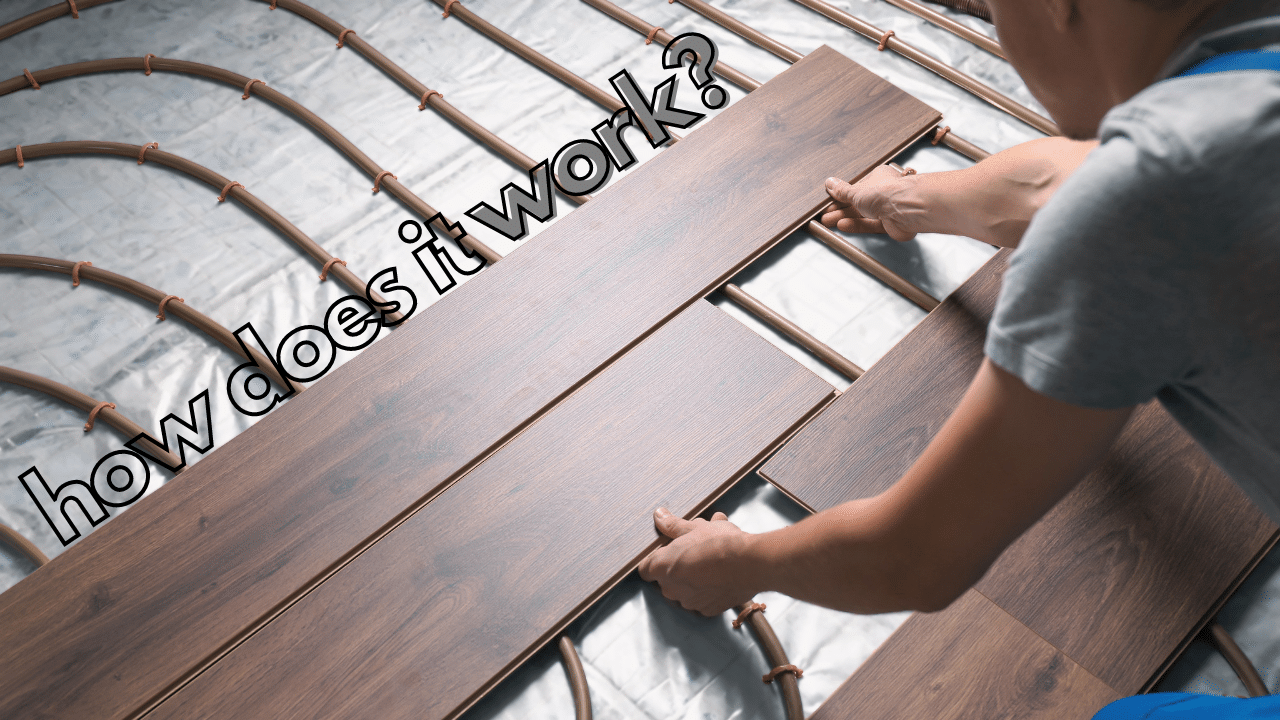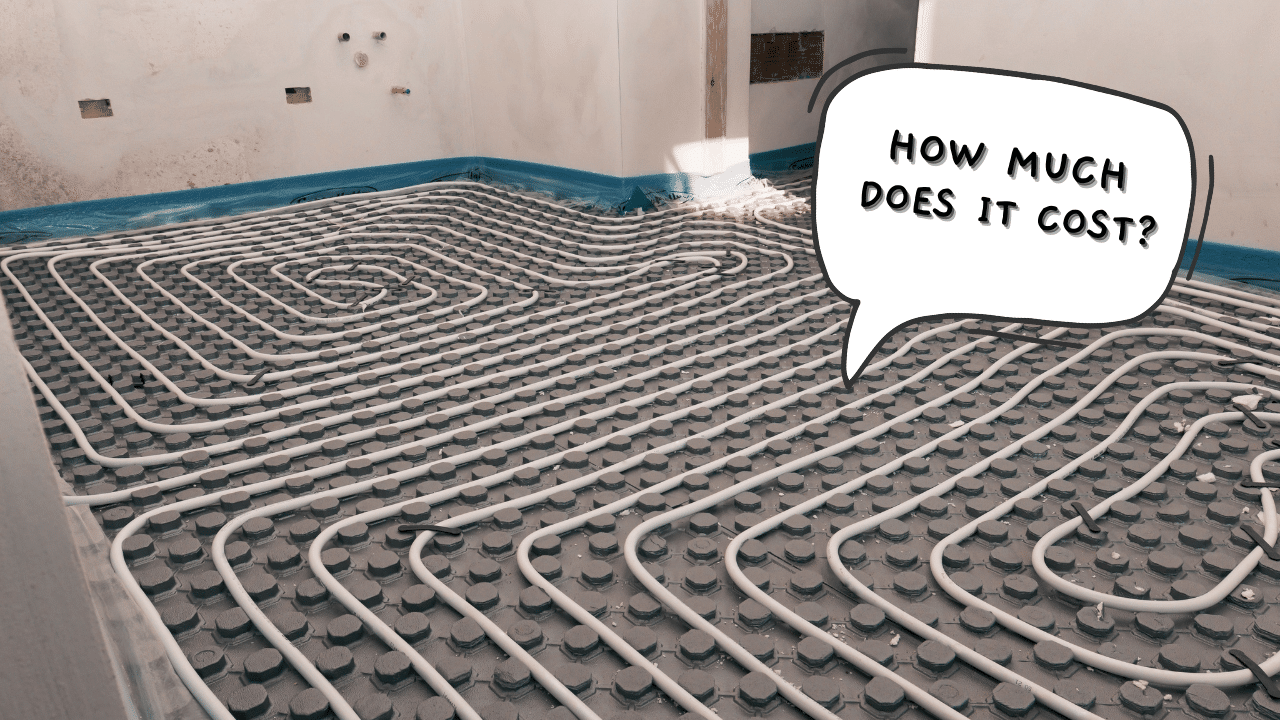Saving yourself from the shock of cold floors on your feet might seem a little luxurious. But standard radiant floor heating costs range between $2,185 and $7,900. It doesn't exactly sound too far-fetched considering its efficient heating benefits.
Several homeowners in the United States consider radiant floor heating a necessary part of their homes, primarily if they are in areas with brutal winters.
Like any other home improvement project, the total cost you will ultimately pay depends on several factors– installation type, location of your property, local labor rates, and floor covering.
Radiant Floor Heating Cost Breakdown
For your convenience, here's a breakdown of radiant floor heating costs at a glance:
On average, radiant floor heating installation costs between $2,185 and $7,900. Meanwhile, you will need to set aside $8 to $26 per square foot with a hydronic heating system. It uses a boiler to warm the home sufficiently, distributing heated water to the pipes.
Opting for an electric system will cost a little more at $11 to $33 per square foot. If you're wondering about the perfect time to install radiant floor heating at home, it's when the floor is currently ripped out. Tearing up the old floors to install them in place may only cost you more.
Hence, if you're amid a home renovation or remodeling project, consider it the best time to install radiant heating underneath the floors.
Many consider it as an add-on luxury to a bathroom or kitchen, but beyond that, it's also a terrific energy-efficient method to keep your house warm.
What are the Different Types of Radiant Heat?
In installing radiant heat in your residence, you have several options to choose from: electric, hydronic, or air-heated systems.
The cost of radiant floor heating will primarily depend on your chosen type. That said, let’s discuss three of the most popular radiant heating types.
Radiant Heat Type | Average Costs |
|---|---|
Electric Systems | $11 - $33 per square foot |
Hydronic Systems | $8 - $26 per square foot |
Air-Heated Systems | $18 - $26 per square foot |
Electric Systems
The cost of an electric radiant floor ranges from $19,000 to $36,000.
This floor heating system utilizes electrical matting under the subfloor, making it suitable for providing heat in specific areas of the floor.
Accordingly, you will need to pay an electrician to connect the system to a power source. It may easily cost you more than other heating systems, but you may enjoy it for more than 35 years (given proper maintenance and use, that is).
Most electric radiant heating systems are designed to be a supplemental heat source in a living space instead of a primary one. Radiant electric floor heating pads are also available, which you may install under laminate or engineered hardwood floors.
Hydronic Systems
A radiant hydronic floor system costs $6,900 to $10,350, with an additional $8 to $26 per square foot. To cover an entire house, it may quickly add up to $16,100 or more.
A hot water radiant heating system will have cheaper operating costs than electric ones since water is a good conductor of heat and requires less running time. It is similar to the air-heated system, with several pipes or tubes installed beneath a room's flooring. These have hot water which is heated by the boiler.
Hydronic heating systems are considered the cheapest choice, making them an excellent option for homeowners with a limited budget.
Take note that the required number of temperature zones may add up to the costs, though. If you wish to heat a large room, you may need to install more zones.
Air-Heated Systems
Standard air-heated systems start at $18 to $26 per square foot. This system forces warm air through the tubes installed under the floors. Most heated-air systems are run by solar power. Aside from paying the cost of installing a tube system, you will also need to install solar panels in place.
Now that we've covered the different types of radiant floor heating, keep in mind that your preferred pump type may hike up the project costs. Generally, an electric floor heating system will cost you more than a boiler-based unit.
What Type of Radiant Floor Heating Can I Get on My Budget?
Every homeowner has different price points for a radiant floor heating project. Here’s a quick breakdown of what you can expect to get depending on your budget.
Budget | Type of Radiant Floor Heating |
|---|---|
$1,900 | With $1,900, expect to install a radiant heating system for a single room. |
$5,000 | Although this budget is still on the lower end of the scale, $5,000 allows you to cover a little more area. In particular, you can cover about 400 square feet of living space for a hydronic heating system. |
$10,000 | With a budget of $10,000, you can cover a small home less than 2,000 square feet with a more cost-effective radiation heating type (boiler-based). Although if you choose a high-end system such as an electric type, you will only get limited coverage. |
$20,000 | A $20,000 budget can afford you a whole-house hydronic floor system. Typically, this costs you around 14,000 to $48,000. An electric system will cost you more, somewhere between $19,000 and $36,000. |
$50,000 | The price point of $50,000 can give you a luxurious, upscale radiant floor heating system for your home. It will already give you the best radiant floor heating in the market, covering large-sized houses measuring 2,500 to 8,500 square feet. |
Factors Affecting Radiant Floor Heating Costs
As previously mentioned, there are a couple of defining factors that may influence the total costs of your radiant floor heating project. It includes the following:
Size of the Area
The size of the space you want to install radiant floor heating on is considered the most influential factor that defines your total bill. Naturally, a single room will cost you less than what you'd typically pay when heating a larger home.
Area Preparation
The total project costs will also depend on how much work your installer will need to do to prepare the site for radiant heat flooring installation.
It’s common for some contractors to do some digging, compacting, and foam installation to ensure the area is ready for the installation process. In some cases, this may include a necessary clean-up of the space afterward.
Distance of your Property
If your installer has to drive through hundreds of miles to transport materials and the on-site crew to your home, this may only increase the final price tag of your radiant floor heating project.
Local Labor Rates
Depending on your locality, the cost of labor may vary. It's best to do a quick online search to determine your area's average labor cost for a radiant floor heating project.
Note that some contractors may charge you more, depending on their expertise and the project's scope.
How does the Radiant Heat System Work?
Radiant heat is produced through the infrared radiation process. Typically, several coils or tubes are installed beneath the flooring. The heat will transfer from the warm coils to the surrounding air.

Since convection causes the rising of warm air, it then circulates it throughout the entire living space. It will take around 30 to 60 minutes for your cold floors to be heated thoroughly. Radiant heating can be installed in various floor types, from laminate to wood. Aside from floors, this heating system may also be placed in the ceilings and walls.
Picture this: it's winter, and you get up to prepare for a busy day ahead. As you enter the bathroom, you're pleasantly greeted with the tiles being warm to the touch. The tiles on the kitchen and the carpet in the living room are warm, too!
Undoubtedly, your $2,185 and $7,900 investment on radiant floor heating costs sounds worth it.
What are the Benefits of Radiant Floor Heating?
The U.S Department of Energy claims that radiant floor heating is more efficient than forced-air or baseboard heating systems.
If that's not convincing enough, here are some benefits you can expect in radiant floor heating.
More Comfort
What makes radiant heating far more comfortable than other systems? For one, it feels warmer since the heat is conveniently delivered right where you are– just near the flooring.
All surfaces in the room with radiant heated floors are warm to the touch. Additionally, your home will also have cleaner air without any dust and allergens.
Lower Energy Costs
Hydronic radiant floor types can cut energy costs since lower air temperatures already make you feel comfortable and warm. It enables you to lower the thermostat.
Running a boiler at lower temperatures can also help increase its average lifespan, giving you extra savings down the line. Similarly, you can install a programmable thermostat for your radiant heated floors to control air and floor temperature.
An entire house radiant floor heating is said to help save up to 40% of your monthly heating bills. Most homes in the U.S reported an average of 12% in savings, though.
Pros and Cons of Radiant Floor Heating
Although underfloor heating is the most comfortable way to warm your feet on chilly nights, is it truly worth shelling out the additional cost?
To determine if a radiant floor heating system suits your home needs, let’s discuss its advantages and drawbacks in detail. Knowing the pros and cons can help you make an informed decision before getting started on the project.
Pros:
Cons:
Final Thoughts
Bottom line, it's unlikely to find someone unimpressed by the comfort brought by heated floors. That said, radiant floor heating proves to be an excellent choice for your home heating system. It's comfortable, highly efficient, cleans the air inside your home, and has a quiet operation.
It may appear as a luxurious addition; it's not strictly limited to upscale properties. You can opt to have it installed at the comfort of home, regardless of your set budget.
Trust us; you'll love the comfort of radiant heat to keep you warm on cold nights. (Related: The Comprehensive Materials, Fixtures and Accessories List For Bathroom Remodeling) Easily mimic the warm feeling of a sunny day even in the middle of winter– with only $2,185 to $7,900. It’s one home improvement project you might want to consider ASAP.

